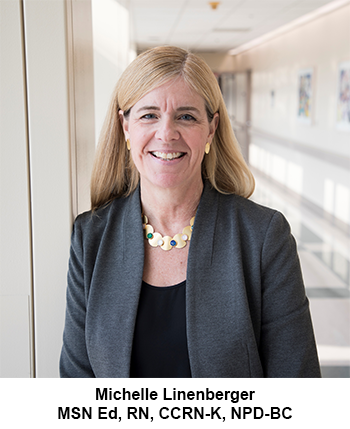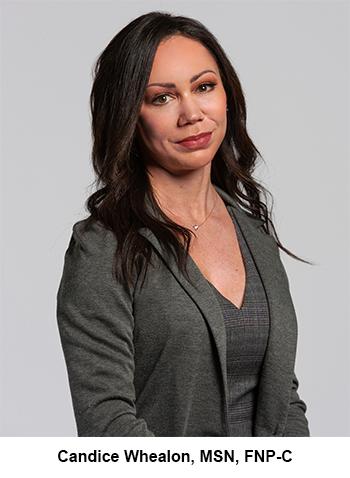By Dorsey Griffith
Contributing Writer
 California nurses played many essential and often new roles during the pandemic, from providing critical care at the hospital bedside to COVID-19 testing and vaccination to seeing patients via telemedicine. As providers begin to take stock of the past 15 months, valuable learnings have emerged that many say could – and should inform health care for the foreseeable future.
California nurses played many essential and often new roles during the pandemic, from providing critical care at the hospital bedside to COVID-19 testing and vaccination to seeing patients via telemedicine. As providers begin to take stock of the past 15 months, valuable learnings have emerged that many say could – and should inform health care for the foreseeable future.
For Michelle Linenberger, MSN Ed, RN, CCRN-K, NPD-BC, it’s the value of peer support programs and a health care organization’s commitment to helping them thrive. For Candice Whealon, MSN, FNP-C, it’s an appreciation of how people cope with stress and the importance of ensuring that everyone has access to the comprehensive physical and mental health care they need.
Linenberger, a Children’s Hospital Nurse Educator and coordinator of the Support U Peer Responder Program at UC Davis Health, has long been concerned about the impact of stress, guilt or grief on health care providers following a traumatic patient-related event. With 20 years of experience in pediatric critical care, dealing with the aftermath of drownings, child abuse and other traumatic events, she has worked with other clinical and health system leaders to establish curriculum to train nurses and other providers in peer-to-peer support.
The program, which is confidential, aims to fill the gap between when an adverse event occurs and when the person can access resources to help them cope after an event. Events may be the death of a patient, workplace violence, ordering or medication errors, litigation or caring for a violently injured patient.
At UC Davis Health, peer responders are trained to provide confidential listening, safe environments to discuss stresses and experiences, emotional support, compassion and understanding.
“There is literature that shows that having a check-in from a peer responder decreases post-traumatic stress,” Linenberger said. “We are moving away from silence, isolation and shame.”
Peer responders may be any staffer who wants to be trained, whether a manager, lift team member or pharmacists. They may support any health care provider, whether a physician, respiratory therapist or nurse, for example.
She said the pandemic intensified the need for the peer support program, and it also helped the program evolve to reach more people and provide easier ways to access it. For example, peer responders can now be identified on their ID badges, and peer-to-peer interactions can take place via Zoom. A wide array of additional support services are made available on the health system intranet.
The overarching goal, she said, is to reduce the burden of human suffering and, hopefully, the loss of talented health care providers to burnout and departures from the health care profession.
Linenberger also is a faculty member for the UC Davis/UC Irvine Clinician Health and Wellbeing Fellowship, a nationwide program that offers clinicians an opportunity to address clinician burnout and improving professional well-being in healthcare.
“We are all just human beings experiencing this tremendous amount of suffering,” she said. “Then you throw in COVID, racial disparities, a colleague’s illness – all of this affects us. We are not there to fix it or to clinically evaluate the situation, but to connect them to resources. Peer support helps us to reconnect and gives us the feeling of solidarity.” 
Candice Whealon knows that many people seek care at urgent care centers or emergency rooms because they lack access to primary care providers. She said that the COVID-19 pandemic highlighted the disparity in two ways. People lost their health insurance or were too afraid to get routine care or treatment because of the risk of infection. Many ended up in the emergency room when their conditions became dire. Others sought help because of substance or alcohol use emergencies, which have surged since the beginning of the pandemic.
On the positive side, she said, providers, and the nursing students she teaches at the University of California, Irvine have a much greater appreciation for the role that substance use plays in coping with stress and anxiety, especially for people who don’t have access to a physician for pain or emotional support or other mental health issues.
She’s also noticed that faculty are modeling how to provide culturally sensitive patient care for their students, and students have excelled at asking sensitive questions of patients about their social needs, safety in the home and other issues.
“In the past, you wanted to maintain privacy, and now, we better understand asking questions is not about invading privacy, but about improving patient outcomes,” she said. “Where we have a lot of work to do is developing the resources to deal with patients’ psychiatric, social, housing, mental health and other needs.”
The pandemic did highlight healthcare and other disparities that must be addressed, she said, citing the privilege to work from home versus risking illness to drive a bus, sell groceries or plant and pick produce as essential workers.
“Until COVID, we never thought of the option to work from home as having less risk associated with physical health. If you were in isolation because of a COVID-19 exposure and you work from home on a computer, you don’t miss a day of pay. Your ability to stay financially stable is different from an hourly employee who lacks benefits and has to go into work.”
That so many people lack access to a primary care provider also came into sharper focus during the pandemic, she said.
“So many patients could have benefitted from having a relationship with a primary care provider for solid medical advice or to get their prescriptions refilled. It’s a trusted source you have who is aware of the medications you are on, the specialists you are seeing.”
Primary care providers are pivotal, for example, in helping hesitant patients understand the value of the COVID-19 vaccine.
“For patients, it can be hard to understand all those messages coming at them,” she said. “Primary care providers can discuss what to expect, help them hash out their insecurities, provide them education and start moving them toward vaccination.”
Fortunately, the explosive growth of telehealth enabled people who otherwise would not seek care to see providers virtually. At UC Irvine’s Student Health Center, she said, they plan to continue using telehealth because it was so successful during the pandemic with students who are more comfortable and skilled in a virtual environment.
If she were to take away one especially important lesson in the pandemic, Whealon said, it would be the importance of being flexible and having an appreciation for how people cope as they juggle health or financial challenges, as well as professional and family responsibilities. Not to mention glitchy sessions on Zoom.
“It was such a shared experience,” she said. “We are learning the importance of being flexible and having some grace.”